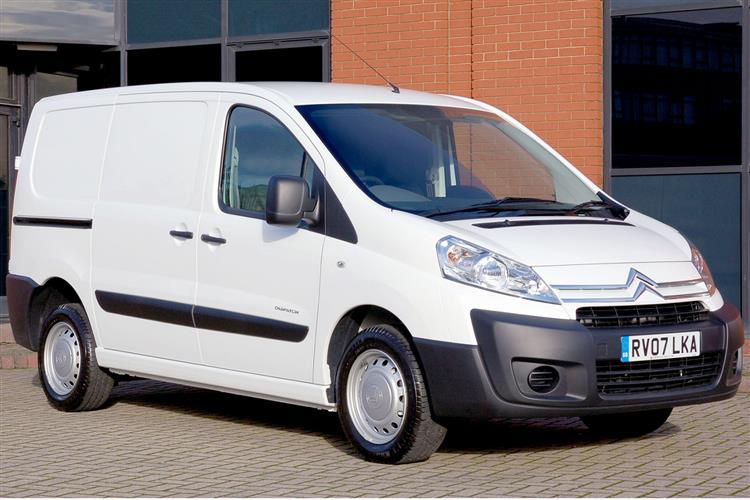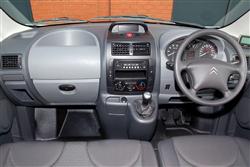This is a sample, showing 30 seconds of each section.
VERSATILITY DISPATCHED (some text hidden) SECTIONED_new_citroendispatch_061108
By Jonathan Crouch
Introductionword count: 79
Citroen's Dispatch is a likable van that does things that bit differently from its key mid-sized rivals. It's good to drive, comfortable over long journeys and it comes very well equipped. Downsides include the loose gearchange, the lack of forward visibility for manoeuvring and possibly what some might see as slightly unusual looks but overall, there's little to prevent UK van drivers forming a solid working relationship with the Dispatch. Let's check it out as a used vehicle proposition.
Modelsword count: 12
5dr medium/large van (1.6 HDi 90bhp, 2.0 HDi 120 & 136bhp diesel)
Historyword count: 178
The Dispatch has long been Citroen's entry in the volume medium-range van sector, where in Europe, Mercedes Vitos, Renault Trafics and Ford Transit Custom models tend to rule the roost. Taking on this lot isn't something you'd want to do single-handed, so at the turn of the century, Citroen chose to share development of the second generation Expert with both Peugeot and Fiat, whose Expert and Scudo LCVs were pretty much identical and offered strong competition throughout this model's production life between 2006 and 2016. The first generation version of this vehicle occupied a kind of no-man's land in the market, bigger than something compact but not large enough to rival proper mid-sized Volkswagen Transporter-class vans. This MK2 model though, got itself sorted out in that regard, with load volumes between 5 and 7m3 that were able to rival anything in the class. Buyers get clever design, proven engines and low running costs in a package that certainly seems to work on paper. This model sold until 2016 when it was replaced by an all-new third generation design.
What You Getword count: 815
Visually, it's quite hard to pigeon-hole this vehicle into a particular market category. You can see that it's bigger than something like a Peugeot Partner or Renault Kangoo-sized Citroen Berlingo but you might question whether it has the volume to take on medium range vans of Vivaro or Vito size. It has. The windscreen is steeply raked creating a wedge-shaped front end with the usual huge Citroenheadlamps and the marque's familiar horizontally split grille. Moving backwards, thick rubbing strips protect the flanks and the tail lights are mounted high up to help avoid costly parking knocks. As for interior comforts, well the low floor means that the cab's easy to get in and though the handbrake lever's oddly situated between the driver's seat and the door, it doesn't get in the way. The seat itself is positioned to suit those who've to jump in and out of their vehicle all the time, with limited height adjustability and a rake and reach-adjustable steering wheel. An advantage this Dispatch offers over Citroen's smaller Berlingo is a properly sized middle third seat. To free up space for this and make it easier for the driver to slide over to the passenger side of the cab, the gearstick has been taken from the floor and mounted on a protruding moulding in the centre of the dash. It still rather gets in the way if you're trying to slide across the cab and limits the middle person's legroom. Still, the third seat is useful to have - and quite adequate for mates on short journeys or kids you might have to drop off on the way to work. Those who've to spend their working lives in a cab like this will want to see some evidence of care and attention on the part of the designers and sure enough, this Dispatch provides it. The usual shallow bin you get in each door has a moulding designed for a soft drinks can or a small bottle of water, plus there are pull-out cupholders at either end of the dashboard. You can even put drinks on the inside of the lockable glovebox lid, though only if there's no one sitting in front of it to have their knees bashed as it opens. Other storage includes a deep, strangely-sized bin on the top of the dash on the passenger side, cubbies in each corner, a shelf beneath the steering column, a tray beneath the passenger seat and a full-width overhead shelf. It seems strange to think now that the original first generation Dispatch model thought itself big with only 4.0m3 of carriage space to offer, a figure now routinely matched and beaten by many compact little vans. This second generation version is of course, much better provided for, offering from 5.0m3 (if you go for the short wheelbase standard roof version) rising to 6.0m3 (if you choose the long wheelbase standard roof model), before culminating at 7.0m3 for those favouring the long wheelbase high roof version. That latter figure is only 1.0m3 less than Citroen's entry-level Relay model from the next class up. So far so good: onto practicality. A lifting tailgate was an option from new, but most Dispatch vans were ordered with conventional twin side-hinged rear doors that, as usual, open initially to 90-degrees or back to 180-degrees if you unlock the door stays. Heaving weighty cargo aboard is made easier by a low 540mm rear loading sill height and if you do a lot of heaving in your line of work, you'll do well if you can find a Dispatch whose original owner fitted it out with the optional pneumatic suspension option, this set-up able to drop the loading height down as low as 500mm. Either way, the rear door aperture of 1245mm in width and 1272mm in height should enable you to get most loads in quite easily. Once you do, there's a useful load length of 2255mm in the short wheelbase model (2586mm in the lwb version) and height that's measured at 1450mm in the standard roof version and 1750mm if you've gone for a high roof. Whichever Dispatch you choose, the load area width is 1602mm, which narrows to 1250mm between the wheelboxes. For those occasions when it's easier to get things in at the side, there's a couple of sliding doors provided with apertures (924mm wide and 1293mm high) big enough to accept a euro pallet. To keep stuff moving from around on the move, eight tie-down points are provided, but if you forget to use them and things slide forward, a pronounced lip at the cab end of the load bed is helpful. It should keep your packages from scraping the half-height protective panels provided on the doors and above the wheelboxes and clanging against the load restraint frame that's fitted to models lacking the optional full width fixed bulkhead that substantially improves cab refinement.
To see the full road test text contact us on 0330 0020 227
Pictures (high res disabled)

.jpg)
|
.jpg)
|
.jpg)
| |||
.jpg)
|
.jpg)
|
.jpg)
| |||

|
Scoring (subset of scores)
Category: Vans
| Performance | |
| Handling | |
| Comfort | |
| Space | |
| Styling, Build, Value, Equipment, Depreciation, Handling, Insurance and Total scores are available with our full data feed. | |



